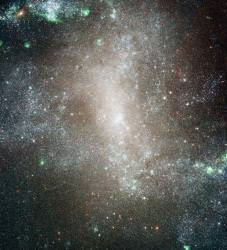 Massive globular clusters are some of the oldest objects in the Universe, held together by the collective gravity of their stars. Open star clusters, on the other hand, don’t live so long.
Massive globular clusters are some of the oldest objects in the Universe, held together by the collective gravity of their stars. Open star clusters, on the other hand, don’t live so long.
This is according to new data gathered by the Hubble Space Telescope. The space observatory was focused on barred spiral galaxy NGC1313. It turned up a number of very young massive stars (B-type), which were flying solo through the galaxy. These stars are normally born in compact clusters, and they have a very short lifespans – rarely living beyond 25 million years.
So, these stars have been floating free in the galaxy, and they’re not dead yet. That means the compact cluster they formed in has long come apart. And since B-type stars don’t last longer than 25 million years, these clusters must come apart quickly.
But other stars in the cluster die even more quickly. The really large O-type stars are so massive they die as supernovae within a few million years ago. Long before the cluster has a chance to come apart. In fact, it might be these supernovae explosions that actually help speed up the clusters’ disintigration.
Source: Hubble News Release
